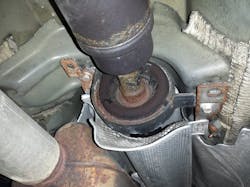Unless you have just started in the automotive field in the last few weeks, you likely have faced this work order. A customer is concerned about exhaust noise.
You get in the vehicle and start the road test. The exhaust is quiet, but the familiar hum or growl of a wheel bearing is oh so familiar. You return to the shop and alert the front desk service adviser that the customer has a bad wheel bearing and the exhaust on the vehicle is just fine.
Identifying the noises of a bad wheel bearing is often the easiest part of the failed wheel bearing process. Identifying and isolating which wheel bearing is causing the noise can often be the difficult part.
A wheel bearing is considered a low maintenance part of the vehicle today, unlike when the rear-wheel-drive vehicle was still prevalent. It was considered a regular maintenance item, and manufacturers like GM recommended that the wheel bearings be cleaned and repacked every 15,000 miles.
But with the change to front wheel drive as the norm, those serviceable front wheel bearings quickly faded away and the advent of the hub or press fit wheel bearing became the norm.
Just because a wheel bearing is considered a low maintenance part doesn’t mean that it will last forever. They do have a lifespan and they do fail and need to be replaced. Wheel bearings are a vital part of the operation of a vehicle and are considered a critical safety component. After all, they are carrying the weight of the vehicle, allowing for steering, braking and suspension movement.
The wheel bearings that are in use today are permanently lubricated, hermetically sealed and either the steel (ball) bearing or the tapered bearing type. They are carefully assembled to allow the wheel to rotate smoothly, quietly and for a substantial amount of time.
Today’s sealed wheel bearings don’t require any service in their lifespan, and that lifetime is expected to be about 100,000 miles or more. But they do and can fail.
Before we talk about how to diagnose a failed or failing wheel bearing, it is good to understand why a wheel bearing fails.
Potholes, rough roads, overloading, unbalanced tires, accidents, improper bearing installation/replacement, radical car modification and other things can cause wheel bearing failure. But the breakdown of lifetime wheel lubrication/grease is the most common cause of wheel bearing failure.
They are most often caused by the failure of the lubrication that is sealed inside the bearing assembly.
Water and debris can eventually get past the seals that are designed to keep this stuff out and permeate into the permanent grease responsible for lubricating the bearing surfaces.
Once the grease that is protecting the precision rolling surfaces becomes contaminated it will be displaced, and metal-to-metal or metal-to-debris contact can occur creating yet more debris.
As this debris starts to accumulate the bearing assembly will begin to encounter more and more friction. This excess friction can allow for changes in rotational direction or geometry (wobbling), creating noises, steering wheel movement, Anti-Lock Braking (ABS) issues and in a rare, worst-case scenario — catastrophic failure.
Noise is the most common complaint of the metal-to-metal contact of a failed wheel bearing. The customer may not even notice the noise at first because it may gradually get louder, and the customer has become acquainted with the noise. But wheel bearing noises are common, and that noise can be used to help diagnose where it is coming from.
Even though noise is the largest complaint that a failed wheel bearing will create, ABS faults are also common. The ABS sensor magnetic encoder ring can be incorporated into the outer seal of the bearing assembly. Some of these encoder rings are integrated into the seal; others are bonded to the seal and over time can corrode, separate, crack and fall off. This will result in an ABS code being set and the only way to repair the issue is to install a new wheel bearing assembly.
Because most of the wheel bearings and hub assemblies that we see today are sealed, we need to rely on other methods for diagnostics and the noise of a wheel bearing can help.
If we are performing a road test to diagnose a wheel bearing noise, the cyclical growling, humming noise will generally become louder the faster we travel. It may get louder or quieter or even disappear as we pitch or change the direction the vehicle while driving. This happens because of the weight transfer to the wheels as the vehicle rotates around its center of gravity. You don’t need to be driving fast to perform this check, but fast enough to apply a good load equally to both sides of the vehicle as we pitch back and forth.
When performing this type of wheel bearing diagnostic we want to listen to where the noise gets the loudest. Is the noise louder on the left or the right only when the weight is pitched to that side? That usually indicates the wheel bearing concern is on the side the weight has shifted to. But be aware that this test may show a wheel bearing that gets louder when the weight is off it because the damage to the bearing’s rotating surface may be on the top of the bearing assembly, and the pitching is pulling up in that direction augmenting the noise.
We need to pay particular attention to noises that don’t change when we pitch the vehicle. The cause may not be a failed wheel bearing, but bad tires, bad driveshaft hanger bearings and front CV axle shaft support bearings can often be misdiagnosed as a bad wheel bearing. Other noises such as rear wheel drive differential noises may only occur during deceleration.
Another common issue that will occur with a failed wheel bearing, especially on 4WD pickup trucks, is that an extra steering input will be needed when turning a corner or on a long sweeping curve. These wheel bearing failures typically do not make any noise, don’t cause a vibration or any other driver concerns. But when the driver starts a turn, when the weight of the vehicle shifts, extra steering input will be needed to keep the vehicle aimed in the direction that the driver wants to go. This will happen because the wheel bearing is now allowing excess lateral, axial or angular movement and changing the front-end geometry of the truck.
Once we have identified and verified that we have a failed wheel bearing concern from the road test (we may or may not have an idea which bearing has failed), we can begin the on-hoist diagnostic.
Once the vehicle is safely raised off the ground we can begin a visual wiggle test inspection of the wheel bearing assembly. We will be looking for any excessive movement in any of the wheel bearing assemblies. Grab the wheel at the top and bottom or at 10 o’clock and 4 o’clock, which is my go-to position for wheel bearing inspection. I have found that not being at the 12 o’clock and 6 o’clock positions will show more wheel bearing excessive play than the typical top and bottom location.
We are not expecting any movement or play. If there is movement that is likely the bad bearing especially if it is accompanying the road test noise location.
When using this wiggle test, the extra steering effort 4WD truck front hub/wheel bearing usually shows extreme movement.
Don’t forget to inspect the rear wheel while performing this test as they can fail even though there typically isn’t as much weight on the rear wheel bearings as the front assemblies.
If we still haven’t identified the noise-causing culprit at this point, or we have a good idea what bearing is failing but want to ensure we are changing the correct one, I like to use the electronic stethoscope or chassis ear method to verify which bearing has failed.
The use of an electronic ear will allow for the placement of sensors on each of the hubs/knuckle assemblies. I will then road test the vehicle at a speed that produces the wheel bearing noise or pitch the vehicle to get the bearing to emit the growling noise that the electronic stethoscope will pick up and send back to the headphones. I will switch from one transmitter to the next to isolate what corner of the vehicle the noise is coming from. I will often get a coworker to ride with me so they can listen while I get the vehicle to make the noise. Using the electronic stethoscope has saved a lot of time and the replacement of tough to diagnose wheel bearings over the years.
Once we have made the decision on which wheel bearing has failed, we can start on the replacement. Wheel bearing or hub replacement may require the use of some special tools, especially if the wheel bearing is a press fit into the hub or knuckle. The use of a hub tamer kit will make this type of bearing replacement substantially easier. Don’t forget to pay attention to detail when doing these types of bearing replacements. Make sure that the retainer ring groove is clean, a new retainer ring is used, and that the assembly is installed squarely with a small amount of lube to aid in the installation.
With most wheel bearings being a complete hub assembly, the replacement of a hub is often quite straightforward, provided you don’t live in the rust belt. Some aftermarket bearing companies will now sell the complete knuckle assembly to speed and ease the wheel bearing replacement and ensure that all the parts that should be changed are changed.
The final step to completing either the press-in bearing type or the hub assembly type wheel bearing replacement is the careful torquing of the axle nut to the prescribed torque. One of the greatest causes of premature wheel bearing failure following its replacement is the improper torquing of the axle nut.
The axle nut torque will preload the wheel bearing. If the axle nut is under torqued it will allow too much movement causing irregular loading and excessive bearing wear. And if the axle nut is over torqued it will produce unnecessary load causing the bearing to overheat.
It can’t be stressed enough to stay away from holding the impact gun on the nut and guessing how tight the axle nut is. Using the proper torque wrench to ensure the replacement is done correctly will give the same service life as the original.
About the Author

Jeff Taylor
Jeff Taylor is a seasoned professional at CARS Inc. in Oshawa with 40 years in the automotive industry. As a skilled technical writer and training developer, he holds licenses in both automotive and heavy-duty vehicle repair. Jeff excels in TAC support, technical training, troubleshooting, and shaping the future of automotive expertise.
